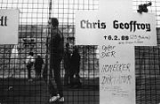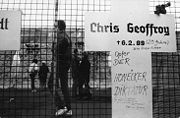
Chris Gueffroy
Encyclopedia
Chris Gueffroy was the last person to be shot while trying to escape to West Berlin across the Berlin Wall
. He is often erroneously named as the last person to die in the attempt to cross the wall, but he was in fact only the last to be killed through the use of weapons, and the second-last to die in an escape attempt. Winfried Freudenberg
died in the crash of an improvised balloon aircraft by which he crossed the border into West Berlin on March 8, 1989.
 Together with his friend Christian Gaudian, Gueffroy attempted on the night of February 5–6, 1989, to escape from East Berlin
Together with his friend Christian Gaudian, Gueffroy attempted on the night of February 5–6, 1989, to escape from East Berlin
to West Berlin
, along the Britz district canal. The two believed that the Schießbefehl, the standing order to shoot anyone who attempted to cross the wall, had been lifted. Climbing the last metal lattice fence, the two were discovered and came under fire from the NVA
border troops. Gueffroy was hit in the chest by ten shots and died in the border strip.
Gaudian, badly but not fatally injured, was arrested and was sentenced on May 24, 1989, to an imprisonment of three years by the Pankow
district court for attempted illegal border-crossing of the first degree ("versuchten ungesetzlichen Grenzübertritts im schweren Fall").
In September 1989, Gaudian was freed on bail by the East German government and on October 17, 1989, he was transferred to West Berlin.
 The four border guards involved at first obtained an award (Leistungsabzeichen der Grenztruppen) from the chief of the Grenzkommandos Mitte border guards, Erich Wöllner, and a prize of 150 East German Marks each. However, after the reunification
The four border guards involved at first obtained an award (Leistungsabzeichen der Grenztruppen) from the chief of the Grenzkommandos Mitte border guards, Erich Wöllner, and a prize of 150 East German Marks each. However, after the reunification
of East and West Germany, they were prosecuted by Berlin regional court. Two of them were released in January 1992. One got a suspended sentence. The latter, Ingo Heinrich, who was responsible for the mortal shot in the heart, was at first sentenced to three and a half years of jail. On appeal, the Bundesgerichtshof (High Court of Justice) in 1994 reduced the penalty to a suspended sentence of two years.
In 2000, two SED
functionaries, Siegfried Lorenz and Hans-Joachim Böhme, were tried for the death of Gueffroy and two other young men, but acquitted as the judge could find no evidence that they might have been able to lift the shoot-to-kill order. The case was retried on 7 August 2004, and the two men were found guilty and given suspended sentences of 15 months each. The judge explained that the short sentences were due to the length of time since the events. This was the last case concerning deaths on the inner German border.
On June 21, 2003, which would have been his 35th birthday, a monument to Gueffroy was erected on the bank of the Britz district canal. The monument was designed by Berlin artist Karl Biedermann. One of the crosses at the White Crosses
memorial site next to the Reichstag building is devoted to him.
Berlin Wall
The Berlin Wall was a barrier constructed by the German Democratic Republic starting on 13 August 1961, that completely cut off West Berlin from surrounding East Germany and from East Berlin...
. He is often erroneously named as the last person to die in the attempt to cross the wall, but he was in fact only the last to be killed through the use of weapons, and the second-last to die in an escape attempt. Winfried Freudenberg
Winfried Freudenberg
Winfried Freudenberg was the last person to die in an attempt to escape from East Germany to West Berlin across the Berlin Wall....
died in the crash of an improvised balloon aircraft by which he crossed the border into West Berlin on March 8, 1989.

East Berlin
East Berlin was the name given to the eastern part of Berlin between 1949 and 1990. It consisted of the Soviet sector of Berlin that was established in 1945. The American, British and French sectors became West Berlin, a part strongly associated with West Germany but a free city...
to West Berlin
West Berlin
West Berlin was a political exclave that existed between 1949 and 1990. It comprised the western regions of Berlin, which were bordered by East Berlin and parts of East Germany. West Berlin consisted of the American, British, and French occupation sectors, which had been established in 1945...
, along the Britz district canal. The two believed that the Schießbefehl, the standing order to shoot anyone who attempted to cross the wall, had been lifted. Climbing the last metal lattice fence, the two were discovered and came under fire from the NVA
National People's Army
The National People’s Army were the armed forces of the German Democratic Republic .The NVA was established in 1956 and disestablished in 1990. There were frequent reports of East German advisors with Communist African countries during the Cold War...
border troops. Gueffroy was hit in the chest by ten shots and died in the border strip.
Gaudian, badly but not fatally injured, was arrested and was sentenced on May 24, 1989, to an imprisonment of three years by the Pankow
Pankow
Pankow is the third borough of Berlin. In Berlin's 2001 administrative reform it was merged with the former boroughs of Prenzlauer Berg and Weißensee; the resulting borough retained the name Pankow.- Overview :...
district court for attempted illegal border-crossing of the first degree ("versuchten ungesetzlichen Grenzübertritts im schweren Fall").
In September 1989, Gaudian was freed on bail by the East German government and on October 17, 1989, he was transferred to West Berlin.

German reunification
German reunification was the process in 1990 in which the German Democratic Republic joined the Federal Republic of Germany , and when Berlin reunited into a single city, as provided by its then Grundgesetz constitution Article 23. The start of this process is commonly referred by Germans as die...
of East and West Germany, they were prosecuted by Berlin regional court. Two of them were released in January 1992. One got a suspended sentence. The latter, Ingo Heinrich, who was responsible for the mortal shot in the heart, was at first sentenced to three and a half years of jail. On appeal, the Bundesgerichtshof (High Court of Justice) in 1994 reduced the penalty to a suspended sentence of two years.
In 2000, two SED
Socialist Unity Party of Germany
The Socialist Unity Party of Germany was the governing party of the German Democratic Republic from its formation on 7 October 1949 until the elections of March 1990. The SED was a communist political party with a Marxist-Leninist ideology...
functionaries, Siegfried Lorenz and Hans-Joachim Böhme, were tried for the death of Gueffroy and two other young men, but acquitted as the judge could find no evidence that they might have been able to lift the shoot-to-kill order. The case was retried on 7 August 2004, and the two men were found guilty and given suspended sentences of 15 months each. The judge explained that the short sentences were due to the length of time since the events. This was the last case concerning deaths on the inner German border.
On June 21, 2003, which would have been his 35th birthday, a monument to Gueffroy was erected on the bank of the Britz district canal. The monument was designed by Berlin artist Karl Biedermann. One of the crosses at the White Crosses
White Crosses
White Crosses is a memorial for those who died during the Cold War at the Berlin Wall. It is located at the shore of the river Spree in Berlin next to the Reichstag building, which houses the German parliament...
memorial site next to the Reichstag building is devoted to him.
See also
- Sven HüberSven HüberSven Hüber is a former political officer of the border troops of the German Democratic Republic and today chairman of the main personnel council of the German Federal Police....

